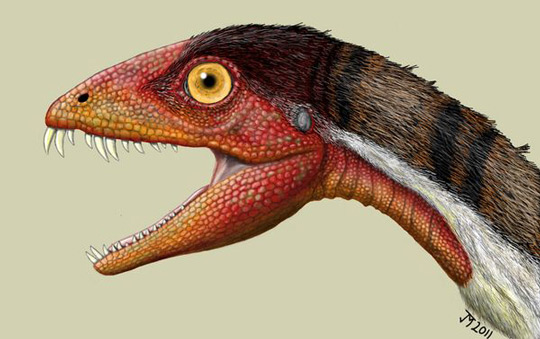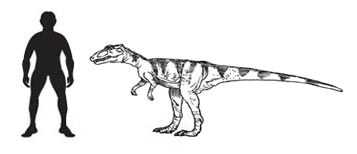Little “Demon” from Dawn of the Dinosaurs
New Dinosaur Discovery Helps Explain Diversity of Theropods
The Ghost Ranch location in New Mexico (United States) is famous for its amazing vertebrate fossils that date from the Late Triassic. Perhaps most famously of all, this fossil rich location has provided palaeontologists with many specimens of the small, agile theropod Coelophysis. Now a new type of meat-eating dinosaur has been discovered, one which might provide evidence as to how the theropods diversified during the remainder of the Mesozoic.
In a paper published in the scientific journal “The Proceedings of the Royal Society B (Biology)”, researchers describe a small, predatory dinosaur, whose fossil remains may indicate how larger, later theropods evolved. The dinosaur has been formally named as Daemonosaurus chauliodus, the name means “buck-toothed evil spirit”.
Daemonosaurus chauliodus
Co-author of the scientific paper, palaeontologist at the National Museum of Natural History in Washington, D.C. (United States), Hans-Dieter Sues, explained why this dinosaur fossil was so significant.
He stated:
“It has a deep, short snout and these monstrous front teeth. That’s a kind of skull structure for a predatory dinosaur that’s really unexpected for this early point in time.”
An Illustration of the New Dinosaur Species – D. chauliodus

Picture credit: Jeffrey Martz
Scientists believe that the first dinosaurs evolved approximately 230 million years ago in what was to become South America. This group included early versions of two-legged, meat-eating dinosaurs known as theropods. One of the largest of these carnivores was Herrerasaurus (H. ischigualastensis), a fearsome four to five metre long dinosaur whose fossil remains have been found in north-western Argentina.
An Illustration of Herrerasaurus
Picture credit: Everything Dinosaur
To view a range of models which includes a replica of Herrerasaurus, simply click on the link below this paragraph.
CollectA prehistoric animal models: CollectA Age of Dinosaurs Prehistoric Life Models.
A substantial gap in the known fossil record in the Middle Triassic had led many palaeontologists to suggest that these early meat-eaters had become extinct.
As Hans-Dieter Sues explained:
“The idea was that there was this early diversification of dinosaurs… but then they went extinct, and more advanced predators took over during the Late Triassic and diversified later at the Triassic/Jurassic boundary, when we know that dinosaur predators greatly diversified and increased in size.”
This new dinosaur, Daemonosaurus chauliodus, known only from skull material and cervical material, helps to bridge the gap in the fossil record and link the two predatory dinosaur groups.
Dr Sues, stated:
“Our new dinosaur, along with another one that was found a few years ago … at the same site,[Coelophysis] indicates that those basal dinosaurs already included a number of early theropods, and that they survived all the way through the Triassic to nearly the beginning of the Jurassic Period.”
Although, only partial remains have been found, the neck vertebrae and the all important skull material show that this dinosaur had several advanced features. For instance, the vertebrae show cavities linked to the respiratory system – bridging the evolutionary gap between the first dinosaurs and the Neotheropoda, the next group of predatory dinosaurs to evolve. This type of respiratory system can be found in creatures alive today – the birds, the very last type of theropod left on planet Earth.
Finding the dinosaur in New Mexico adds another interesting aspect to the discovery.
Dr Sues said.
“We had some inkling that the earliest dinosaurs had made it into the Northern Hemisphere when the super-continent Pangaea was still in existence and animals could walk around on dry land. But the fossil record was limited to South America. The new find gives further evidence that the earliest radiation of dinosaurs did have a wider distribution, and it is due to the incompleteness of the fossil record that we’d found them only in Argentina and Brazil.”


